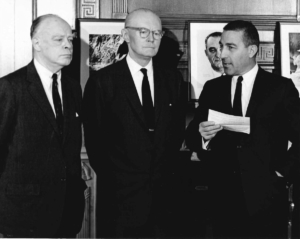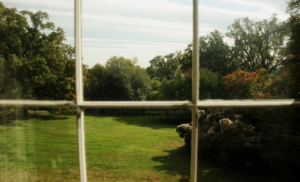The Dower House Celebrates a Milestone Birthday
New research illuminates the history of the 150-year-old Dower House and the close ties between the Beall family, who built it, and the Peter family.
TUDOR PLACE | Open Tuesday – Sunday. Currently on view TANGLED ROOTS. Click TICKETS for reservation times.
As a granddaughter and namesake of Martha Washington, Tudor Place founder Martha Parke Custis Peter inherited several important pieces of her correspondence following the death of the first president.
Since 2015, the University of Virginia has been annotating and publishing the Mrs. Washington’s letters as part of an ongoing partnership between The Washington Papers project (formerly the Papers of George Washington) and the Fred W. Smith National Library for the Study of George Washington at Mount Vernon. Inspired by this project, Tudor Place Archivist Wendy Kail has added to the record by studying her letters and draft replies at Tudor Place and related documents in other archives for what they reveal about the Washingtons’ marriage, deaths, and legacies. Kail’s richly researched essay is presented here in three parts.
The death of George Washington was a stunning loss to his country as well as his family. At Mount Vernon, Martha Washington enlisted Secretary Tobias Lear’s help fielding voluminous letters of condolence, tributes, and requests for memorial locks of the President’s hair. Granddaughter Martha Parke Custis Peter inherited some of this correspondence, including Lear’s drafts, and they remain in the Tudor Place Archive. In Part One of the Washington Letters essay, Archivist Wendy Kail delves into records from Martha’s widowhood to divine what Washington meant to his countrymen.
The essay’s second part, “Legal Aid,” reviews profuse discussions of the wills of both Washingtons, following George’s death in 1799 and Martha’s in 1802. Their estates were orderly, with respected (male) relations as executors, but complicated, and hint at family ties and affections but also possible rivalries. The questions that arose concerning both legacies offer a “case study” of not just the big questions that follow a prominent demise but the numerous quotidian details: Who owned the right to harvest and who must pay for the seed for crops on an inherited farm? Would the executors honor Mrs. Washington’s verbal promise to her granddaughters of Sèvres china? And who owned a pair of mirrors plastered to Mount Vernon’s walls?
The essay’s third and final section, “A Tug of War,” examines one America’s rarest early documents – a letter from George to Martha Washington. In the Tudor Place Archive, it’s one of just three pieces of their personal correspondence in existence. Washington wrote it upon accepting command of the Continental Army, offering a rare if subtle glimpse of the affection between this notably reticent couple. As Kail notes, the general’s almost apologetic argument for service “foreshadows the struggle they both would endure for the next seven years, literally a tug of war between duty and domicile.”
Each essay section contains footnotes, and a Bibliography comprises essay Part Four.
Nora Pehrson explains the origins of her essay on Britannia, written while interning here during her senior at Woodrow Wilson High School in Washington, D.C. Nora now attends Colby College in Waterville, Maine.
I was drawn to Britannia’s story because of an abiding interest in women’s history. I wanted to situate Britannia in the broader context of her time. Around the time that Britannia was on the marriage market, the abolitionist and advocate for women’s rights Sarah Grimké wrote “Letters on the Equality of the Sexes,” in which she asserted that the American woman was “a cipher in the nation” because marriage rendered her invisible in the eyes of the law.
I decided to look at how widowhood might have represented a challenge to the cult of domesticity and especially to coverture laws, which took away a woman’s legal rights upon marriage. Although there are no definite answers to the questions that I began with, my research revealed Britannia’s decision to remain a widow allowed her to own and control the estate, which, remarkably, remained in the same family for six generations. Her “tenacity and perseverance,” Armistead Peter 3rd declared, “did as much as anything in the world to preserve this house to the present day.”
Offered through DC Public Schools and taught by the inimitable Cosby Hunt of the Center for Inspired Teaching, Real World History brings together students from across the city to explore a topic of American history in depth and learn what it means to be a historian. After a semester of reading primary sources, conducting oral histories, and making site visits to archives and museums, students go out into the world and serve as interns at various cultural sites throughout DC. During my time at Tudor Place, I did self-guided research and developed my own tour of the house as a docent. Working with the Education Department under the supervision of Laura Brandt was an amazing opportunity to learn how historic house museums operate and, especially, how to make the stories of the house come alive for the public.
When I arrived at Tudor Place as its first high school intern, I was intrigued by Britannia’s story. Why might she have chosen widowhood over marriage? In a time when the social status of women was so closely connected to the status of their fathers or husbands, why didn’t Britannia remarry? What might her motivations have been? These questions formed the basis of my research project for Tudor Place and the culmination of a year of an extracurricular class called Real World History.
Every visitor who takes a tour of Tudor Place learns the basic outline of Britannia Peter Kennon’s life. Born at Tudor Place in the early years of of the New Republic, Britannia lived for nearly a century. Her decades-long ownership of Tudor Place (from 1854 to 1911) preserved its history and legacy for future generations. Britannia carried out her vision essentially singlehandedly: She was widowed fourteen months into her marriage and never remarried. “Although she had many admirers,” after being widowed in 1844, as her great-grandson Armistead Peter 3rd recalled, she chose to remain single for the rest of her life.

Armistead Peter 3rd, Tudor Place’s final private owner, donated Tudor Place as a scenic easement to the United States. This provided for the perpetual preservation of the historic buildings and gardens at Tudor Place—the first such easement provided under the Historic Sites Act of 1935. At the ceremony commemorating this landmark agreement, Secretary of the Interior Stewart Udall referred to Peter’s easement as a gift to the nation.
Read the full article by Executive Director, Mark Hudson, here.
Though grand by city standards even when the Peters first purchased it in 1805, the original eight and a half acres of Tudor Place was by no means their largest property. Most affluent urban families of the time owned large farms, and the Peters were no exception. Among the lands Thomas Peter inherited from his father Robert was a tract in Montgomery County that the family called Oakland, part of a coveted royal land grant once known as Conclusion. On it they husbanded not just Peter’s cherished race horses, but also crops, lumber, cows and hogs, some of which were transported to Tudor Place every fall for smoking. Enslaved workers also moved between the two locations, family reminiscences and other records indicate.
To at least two generations of Peters, Oakland represented more than a business or country larder. In this essay, archivist Wendy Kail traces the property’s legacy in law, commerce, and family memory.
« Return to Topics, “Georgetown & the Federal City” or “Land & Business”
« Return to Blog

George Washington’s ties to the land –to Mount Vernon and his other farms, and his extensive knowledge of Lord Fairfax’s extensive Virginia properties–are widely known. But far less has been written about the details of his land speculation far to the west, in the Ohio River valley extending into modern-day West Virginia, Ohio, and Kentucky. In his will, Washington left vast tracts of what was then western Virginia to the future owner of Tudor Place, Martha Peter, and her siblings and cousins. Even less has been recorded about the disposition of these inheritances.
In this deeply researched essay, Archivist Wendy Kail tracks dealings by Washington, his executors and heirs, and their agents to find the answer to a long-standing mystery about the origins of Tudor Place: What was the land sale that paid for it? Specifically, to what property did Thomas Peter refer when he said he bought Tudor Place in 1805 with a “… sum of money received by me upon the Sale of certain real property belonging to my Wife Martha Peter devised to her by her deceased relative Genl. George Washington”?
The source of this nest egg was long thought to be a bequest to Martha Parke Custis Peter from Washington, her step-grandfather, of land in what is now West Virginia. Ms. Kail’s thorough dig through archives including and well beyond the one at Tudor Place identifies that land as 1,425 acres along the Ohio River in Ravenswood, West Va. Placing them in the context of the War of 1812 and the Panic of 1819, she narrates the dealings of Peter, his sons, and their appointed agents to show definitively that Martha Peter’s “Ravenswood Tract” was ultimately sold–and then only with great difficulty–long after Tudor Place was completed.
Along the way, the author unearthed details about Washington’s attitudes, beliefs, and western travels, early American Federalism and the turmoil that surrounded its decline, and the Peters’ real estate savvy and travails. The story, with “cameo appearances” by Presidents Jefferson, Madison and Monroe; the tragic death of young Columbia Pete;, and the early Riggs Bank; has as many twists and turns as the river itself.
Court delays, punishing attorney fees, and prolonged disputes are nothing new in American law, a fact nowhere made clearer than in this account of legal proceedings following the 1802 death of Martha Washington, “The Court Will Come to Order: Dandridge vs. Executors of Martha Washington’s Will,” by Tudor Place Archivist Wendy Kail.
Mrs. Washington’s will, drawn up by Alexandria attorney Charles Lee, named as executors her grandson George Washington Parke Custis, nephews Julius Burbridge Dandridge and Bartholomew Dandridge, and Thomas Peter, the husband of granddaughter Martha Parke Custis Peter and future owner of Tudor Place. The executors wrestled with matters like the assignment of profits from stock and cattle sales, the division of assets named in both her will and that of her (previously deceased) husband, and the evergreen question of whether the practice of law constitutes “a useful trade.”
For additional information, contact collections@tudorplace.org or call 202-965-0400.
Thank you for your interest in the Through their Eyes resource packet! Please provide your name and email address to download this valuable resource.
[wpforms id=”32425″ title=”false”]

